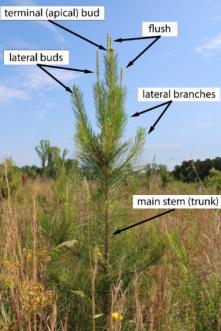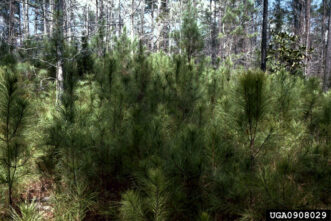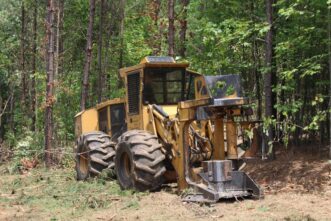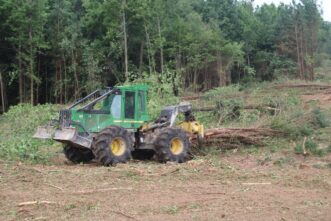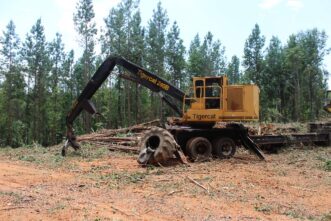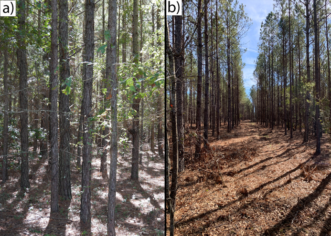Forest management practices, such as thinnings, are recommended to meet landowner management objectives, including generating income, improving habitat for wildlife species, and, most importantly, maintaining a healthy and productive forest. Properly timed thinnings in pine stands will provide all these benefits. Thinnings are forest management activities that are carried out to reduce stand density and improve growth of the stand.1 The objective of thinning is to favor the healthiest and best-formed dominant trees in the stand by removing suppressed, forked, crooked, and diseased trees. This allows residual trees to take advantage of additional available site resources (water, light, and soil nutrients), potentially increasing their growth rate and value when harvested. Properly timed thinnings throughout the rotation can more than double the diameter of trees at the final harvest compared to an unthinned stand.1 This article informs forest landowners and land managers why pine tree physiology determines the spacing and number of seedlings needed for successful pine stand establishment, how a thinning schedule is selected, different thinning methods, and the benefits of thinning to the residual stand.
Pine Tree Growth Characteristics
Trees, like humans, can grow in two directions at the same time. They elongate at their shoots and roots to increase their height (primary growth) while at the same time growing in girth to increase the diameter of stems and branches (secondary growth).2 The cells responsible for developing shoots and roots are apical meristems.3 Growth habitat varies between species and will determine the tree’s shape, which can then dictate the value of that species for wood products. The commercially important southern yellow pine species of loblolly pine (Pinus taeda), longleaf pine (Pinus palustris), shortleaf pine (Pinus echinate), and slash pine (Pinus elliottii) have a shoot growth pattern classified as monopodial growth, where a terminal bud elongates to initiate height growth3 (figure 1). Pines can flush multiple times in a single growing season, and the number of flushes relate to site quality, weather, and genetics.4 A flush means the growth of new needles on all branches (figure 1). This includes additional height growth. Pine trees also exhibit strong (excurrent) apical dominance, with elongation of lateral buds below the terminal (apical) bud suppressed by plant hormones called auxins (figure 1).5 These factors serve to create a main stem or trunk, with a crown composed of outward-growing branches in mature trees.
Seedling spacing during establishment is essential in utilizing the southern yellow pine species’ growth habits to maximize the stand’s growth potential. While natural regeneration is a viable option for reforestation, it requires planning for adequate seed fall and implementation of site preparation to control competing vegetation before harvest for natural regeneration to be successful. Abundant seed crops, also called bumper seed crops, for loblolly pine commonly occur every three to five years, while longleaf pine can be as infrequent as every ten years.6 Depending on when a stand is harvested, this can often lead to a “feast or famine” situation, with either too few or too many seedlings per acre requiring pre-commercial thinning (figure 2).
Artificial regeneration, or the planting of pine seedlings, began in the 1920s by the US Forest Service to reforest cutover timberland and abandoned farmland, expanding over the next few decades as pulp and paper manufacturing grew across the south.7 In the early 1950s, there were less than 2 million acres of pine plantations in the South, but this number grew to over 7 million acres by 1962 due to the Soil Bank Program, the predecessor of the Conservation Reserve Program.8 Development of a range of forestry herbicides in the 1970s and 1980s improved competition control on harvested sites, reducing mechanical operations, which can negatively impact seedling growth by causing uneven distribution of organic matter and topsoil across a site.7 Additionally, the advent of pine tree improvement programs in the 1950s improved tree growth and stem quality. It increased resistance of trees to disease, resulting in rootstock, which was more desirable than relying on natural regeneration. These factors combined grew the number of pine plantations to over 30 million acres in the South by the beginning of the 21st Century.7
The desired number of seedlings to successfully establish the next stand of pine trees will depend on landowner objectives. Planting recommendations usually range from around 400 to over 700 trees per acre, with lower stocking favoring wildlife habitats. Table 1 provides a quick reference to the number of seedlings needed based on common spacing dimension. Wider spacing allows additional sunlight into the stand, increasing the variety, quality, and quantity of forages and creating a greater diversity of cover types.9 The more open the stand, the more lateral branches the pine seedlings will produce in response to increased sunlight until canopy closure, often growing limbs along the entire stem length. The resources spent on growth of lateral branches may reduce those available for height growth.1 However, in loblolly pine, it has been shown that a wider spacing increased overall tree height.10 More closely spaced trees encourage increased height growth, slower radial growth, and smaller lower limbs until crown closure. Widely spaced seedlings have greater radial growth than closely spaced stems, increasing juvenile wood, which can lower the value for dimensional lumber at harvest.11 However, site quality and the genetic status of the seedlings should always be considered when selecting a planting spacing.
Table 1. Reference guide for trees per acre based on common tree spacing dimension.
| Spacing by Feet | Trees per Acre (TPA) |
|---|---|
| 6 X 10 | 726 |
| 6 X 12 | 605 |
| 7 X 10 | 622 |
| 7 X 12 | 519 |
| 8 X 8 | 680 |
| 8 X 10 | 544 |
| 8 X 12 | 454 |
| 9 X 9 | 538 |
| 9 X 10 | 484 |
| 10 X 10 | 435 |
Genetic Stock of Pine Seedlings
Tree improvement research programs have increased forest landowners’ options when selecting and purchasing seedlings for reforestation. Along with increased disease resistance, improved genetic stock can increase productivity over unimproved stock when planted on productive sites following successful site preparation for competition control.12 Steele (2020) describes the categories of improved seedlings available: open-pollinated, controlled mass-pollinated, or clonal/varietal.13 Improved genetic stock has faster growth rates for height and diameter, resulting in stands becoming merchantable at a younger age.12,14 This can result in earlier thinnings. However, concerns about the percent juvenile wood produced from fast-growing rootstock can limit volume from first thinnings that will go for products other than pulpwood.12,14 While lower planting density per acre is often used as a marketing tool to sell a higher quality genetic stock, this practice can further contribute to lower wood quality by increasing diameter versus height growth and reducing wood stiffness.14
Determining a Thinning Schedule
The natural development of any forest results in the healthiest, best-adapted trees expressing dominance through rapid height growth, eventually overtopping and suppressing those trees that are diseased or unable to compete for available site resources successfully. Smith (1986) describes this process as a “race for the sky,” noting that tree height is the main factor in determining how well a tree will survive competition from other stems within a stand.1 Canopy closure is the point in stand development when the crowns of adjacent trees begin to touch. This further increases competition for light between the trees and shades out lower limbs, increasing natural pruning and starting the process where the stand will naturally thin itself. A first thinning can be timed following canopy closure to allow residual trees continued growth.
Although stand age can provide a range of years for determining thinning schedules, there should be other considerations. The criteria for determining when a stand should be thinned and how many trees should be removed include canopy closure, basal area, live crown ratio, and stand volume. Each reflects site quality, stand stocking, and vigor of trees in the stand. A combination of two or more of these factors will usually determine the right timing for a thinning.
Basal Area
Trees per acre is an adequate measure of the density of trees in young stands. However, as a stand matures and the size of individual stems begins to vary, trees per acre will only partially reflect stand density since trees of different diameters take up varying amounts of growing space on a unit of land. Therefore, basal area is used. Basal area is “the area in square feet taken up by an individual tree trunk at DBH (diameter at breast height or 4.5 feet above the ground).”15 Basal area can be determined by measuring tree diameter and using a formula (BA=0.005454xDBH2). For forest management purposes, basal area is expressed as the total growing space occupied by stems on one acre (ft2/acre). If the DBH of all trees on one acre are measured, the sum of their basal area would be used to make management decisions. Measuring all trees in a stand can be cumbersome and costly, so typically, forest managers sample the trees in a stand using a wedge prism.
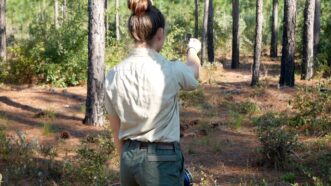
Figure 3. A wedge prism is used to determine basal area. Image credit: Janet Steele, Clemson Cooperative Extension.
A wedge prism is a piece of glass cut at a specific angle that allows trees within a certain distance from the prism to be counted as ‘in’ trees (figure 3). Prisms can be cut at various angles to represent a different basal area that each ‘in’ tree represents per acre. Common prism angles are for basal area factors of 10, 20, or 30 ft2/acre, meaning each tree represents this much basal area per acre. Prisms can be found in forestry online stores, such as forestry-suppliers.com, starting at around $50. A homemade measuring device can also be used; see the article “Homemade Devices to Determine Basal Area” (bit.ly/46eMGgW) for instructions.16 An example of how much basal area can vary based on tree diameter is that it takes almost 230 trees per acre for 8” DBH trees to equal 80 ft2/acre of basal area, but only 57 trees per acre if they are 16″ DBH. Southern pine stands that reach 100–120 ft2/acre of basal area need to be thinned, with a target residual basal area of 60-80 ft2/acre.15,17 These numbers apply to all southern pine species but may vary based on local stand and site conditions and management objectives.
Live Crown Ratio
Live crown ratio is the “percentage of the length of stem [occupied] with living branches.”1 The formula for calculating live crown ratio is LCR = (Total Height – Height to First Live Branch) \ Total Height x 100. This is often measured with a clinometer (measures the angle of elevation or angle from the ground), scale hypsometer (measures distance to the top and bottom of objects), or other height-measuring device. Although this may seem simplistic for use in making a forest management decision, it reflects that even dominant trees in a too-dense stand will eventually have crowns too small to support their size. When the average live crown ratio in a stand drops below 40%, the stand needs to be thinned. A 40% live crown ratio coincides with the point at which stands will begin to self-thin, ultimately sacrificing tree growth that could potentially be harvested.18 To get you started, simply look at a handful of dominant trees throughout your stand to get an idea of live crown ratio. To get detailed information, you will have to measure many more trees or work with a consulting forester to assess the stand conditions. Allowing live crown ratio to drop too low can even result in dominant trees not being able to recover enough to reach their full growth potential.
Stand Volume
Stand volume is often used to describe the merchantable timber volume, or weight, within a stand. While knowing the total stand volume is helpful, the expected harvestable volume or weight is more important. Many logging businesses require at least one truckload of timber per acre and a week’s worth of timber volume to make a harvest profitable.19 A truckload of timber is often considered 25 tons (50,000 pounds) or more. There is a wide range of logging businesses in South Carolina that can produce anywhere from 20 to over 120 truckloads per week.20 While small production logging businesses can handle small acreages with lower harvestable volumes, logging businesses with higher production rates need more acres or harvestable volume per acre, or both, to be profitable. A consulting forester will know the logging businesses in your area and can advise you on who to hire for a timber harvest. Stand volume is typically calculated using tree volume equations specific to individual species, diameters, and heights. If a stand needs more merchantable volume for a commercial harvest, it may be wise to wait another year or two to grow enough volume for a harvest. A consulting forester will be able to do a complete forest inventory for you and advise you on the best management options.
Thinning Operations
Pine thinnings are typically performed using conventional harvesting equipment, including a feller-buncher (figure 4), grapple skidder (figure 5), and knuckle-boom loader with a pull-through delimber (figure 6). For a detailed description of this equipment, consult the publication “Timber Harvesting Equipment in South Carolina” (bit.ly/36hZwRx).21 In a first thinning, the feller-buncher usually removes entire rows of a pine plantation to create a skid trail that the feller-buncher and grapple skidder can drive on. Thinnings can happen at different intensities, but a fourth or fifth-row thinning (figure 7), where every fourth or fifth row of pine trees is removed, is very common in South Carolina. While the entire row is removed, the feller-buncher will selectively remove additional trees from residual rows between the skid trails.
The thinning process removes any undesirable trees of low vigor or bad form that are unlikely to grow into valuable timber products. The feller-buncher will create bunches, or bundles, of cut trees in the middle of a skid trail. A specific number of trees is piled so the grapple skidder can carry a whole load of trees to the landing each trip. The landing, or log deck, is where harvested trees will be delimbed by a trailer-mounted loader and pull-through delimber, and it is also where individual products will be sorted. While first thinnings often only produce pulpwood and possibly biomass chips, subsequent thinnings may also have other products such as chip-n-saw, saw logs, ply logs, poles, and more. Skid trails are already established for subsequent thinnings; otherwise, equipment function is the same.
Cost of Thinning
As mentioned before, loggers often require at least one truckload of timber products per acre and about one week of work for a harvest to be profitable. Moving harvesting equipment from one harvest site to another can cost a conventional logging crew $2,000 or more. This cost may only cover the labor and equipment expenses and not account for any lost production. Including lost production, the moving cost often totals $3,000 or more, which must be recovered across the entire volume from the current harvest site.
Based on second quarter of 2022 data, the average cut and load rate for pine plantation thinnings across the southeastern United States was $14.88 per ton in the Piedmont and $14.21 per ton in the Coastal Plain regions.22 This is the average amount a logger is paid to cut and load the products onto a log truck. At the same time, average trucking rate for the first 40 miles from the landing to the mill was approximately $180 per load or $7.20 per ton.22 Logging is a capital-intensive business with hourly machine costs of $100 or more for each machine.23 An average of three pieces of equipment at a logging job means that a logger will need to cut at least 21 tons of merchantable timber per hour to pay for equipment and labor. This, however, does not account for moving expenses to the harvest site, which can be up to $3/ton (assuming $3,000 moving cost, 40 acres harvest with 25 ton/acre).
Stand Damage
Following a thinning, trees can grow into higher valued products if not damaged during harvesting. Damage to residual trees in the form of removed bark and exposed wood fiber can lead to rot and insect infestations, both of which can reduce stem value. Most logging business owners and equipment operators strive to avoid damaging trees while thinning. However, given the size of the harvesting equipment, it is inevitable that some trees will get damaged. Loggers often select bumper trees at turns in a skid trail to help pivot the load behind a skidder. Bumper trees can get damaged but will protect adjacent trees from damage. Seeing a bumper tree during a thinning operation can shock a landowner. However, these trees are typically harvested at the end of the thinning. Despite protective measures, there will always be a few trees with minimal damage left after a thinning. This is normal and not a cause for concern. Often, up to 20% of residual trees have some form of damage, ranging from broken branches to a bark scuff and small areas of exposed wood fiber.24 If more trees than that are damaged during thinning, it is time to talk to the timber buyer or logger to minimize further damage to the stand. To minimize the risk of excessive stand damage, a landowner may want to consider asking for references of recently thinned tracts or contract with loggers that have a good reputation for minimizing residual stand damage. A consulting forester will be able to help with the selection of a reputable logging contractor.
Benefits of Thinning to the Residual Stand
Properly timed thinnings allow a forest landowner to improve the growth and health of the residual stand while earning income from removing suppressed or diseased trees. Such trees would die naturally if left unharvested or continue to grow so slowly that they are of little value at the end of the stand rotation. The desired response in residual trees is increased radial growth and the ability to support an adequate live crown ratio until a subsequent thinning or a final harvest. Generally, a 6- to 8-year thinning cycle will continue to improve tree quality and allow the landowner to focus on growing trees into a desired product class.14
Another critical consideration when conducting thinning operations is that it will maintain a healthy forest with a reduced risk of insect attack, primarily from southern pine beetles (Dendroctonus frontalis; SPB). Overstocked pine stands that have surpassed the target age for a thinning typically have less resistance to beetle attack, particularly those located on drier soils and during periods of extended drought.17 While thinning does not guarantee that a pine stand will not be attacked during a major SPB outbreak, it can lessen impacts since the stand will grow hardy trees due to less competition for site resources. Finally, thinned stands have excellent air movement, which dilutes SPB pheromones and reduces the attraction of additional insects to the trees.17 More information about SPB can be found on the South Carolina Forestry Commission Forest Health webpage (bit.ly/3PG0D1M).
References Cited
- Smith D, Hawley R. The practice of silviculture. New York (NY): John Wiley & Sons; 1986.
- Tonn N, Greb T. Radial plant growth. Current Biology. 2017 Sep [accessed 2022 Aug 4];27(17):R878–R882. https://www.sciencedirect.com/science/article/pii/S096098221730355X.
- Kramer P, Kozlowski T. Physiology of woody plants. Orlando (FL): Academic Press, Inc.; 1979.
- Baker, JB, Langdon OG. Pinus taeda L. Loblolly pine. In: Burns RM, Honkala BH, editors. Silvics of North America, Volume 1, Conifers. Washington (DC): U.S. Department of Agriculture, Forest Service; 1990. Agriculture Handbook 654. P. 497–512.
- Franklin J, Mercker D. Tree growth characteristics. Knoxville (TN): U.T. Extension; 2009 [accessed 2022 Aug 8]. Publication number W227. https://extension.tennessee.edu/publications/Documents/W227.pdf.
- Boyer W. Pinus palustris M. Longleaf pine, In: Burns RM, Honkala BH, editors. Silvics of North America, Volume 1, Conifers. Washington (DC): U.S. Department of Agriculture, Forest Service; 1990. Agriculture Handbook 654. p. 405–412.
- Fox T, Jokela E, Allen H. The development of pine plantation silviculture in the Southern United States. Journal of Forestry. 2007 Oct [accessed 2022 Aug 4];105(7):337–347. http://rothforestry.com/Resources/Fox%20et%20al.%202007.pdf.
- Helms J. Brief history of the USDA soil bank program. Washington (DC): U. S. Department of Agriculture Natural Resources Conservation Service; 1985 [accessed 2022 Aug 9]. Historical Insights 1. https://www.nrcs.usda.gov/Internet/FSE_DOCUMENTS/stelprdb1045666.pdf.
- Moorman C, Hamilton R. Developing wildlife-friendly pine plantations. Raleigh (NC): NC State Extension; 2019 [accessed 2022 Aug 4]. Woodland Owner Notes WON-38. https://content.ces.ncsu.edu/developing-wildlife-friendly-pine-plantations.
- Antón-Fernández C, Burkhart HE, Strub M, Amateis, R. Effects of initial spacing on height development of loblolly pine. Forest Science. 2011 Jun [accessed 2023 Jul 18];57(3):201–211. doi:10.1093/forestscience/57.3.201.
- Clark AI, Saucier JR, Baldwin VC, Bower DR. Effect of initial spacing and thinning on lumber grade, yield, and strength of loblolly pine. Forest Products Journal. 1994 Nov [accessed 2022 Jul 28];44(11,12):14–21. https://www.proquest.com/docview/214631563?pqorigsite=gscholar&fromopenview=true.
- McKeand S, Abt R, Allen L, Li B, Catts G. What are the best loblolly pine genotypes worth to landowners? Journal of Forestry. 2006 Oct [accessed 2023 Mar 8];104(7):352–358. http://webhome.auburn.edu/~starkte/Documents/What%20are%20the%20best%20loblolly%20pine%20worth.pdf.
- Steele J. Seedling selection guidelines for forest landowners. Clemson (SC): Clemson Cooperative Extension, Land-Grant Press by Clemson Extension; 2020 [accessed 2023 Mar 13]. Publication No. LGP 1097. https://lgpress.clemson.edu/publication/seedling-selection-guidelines-for-forest-landowners.
- Schimleck L, Antony F, Dahlen J, Moore J. Wood and fiber quality of plantation-grown conifers: a summary of research with an emphasis on loblolly and radiata pine. Forests. 2018 May [accessed 2023 Mar 8];9(6):298–314. https://www.mdpi.com/1999-4907/9/6/298.
- Dickens W, Morehead D. A guide to thinning pine plantations. Athens (GA): Warnell School of Forestry and Natural Resources; 2015 [accessed 2021 Jul 16]. Publication Number 0010. https://bugwoodcloud.org/bugwood/productivity/pdfs/Guide_thinning_pine_plantations.pdf.
- Pohlman S. Homemade devices to determine basal area. Clemson (SC): Clemson Cooperative Extension; 2020. [accessed 2023 Mar 13]. CU in the Woods Fall 2020 Edition. https://blogs.clemson.edu/fnr/2021/08/20/homemade-devices-to-determine-basal-area/.
- Nowak J, Meeker J, Coyle D, Steiner C, Brownie C. Southern pine beetle infestations in relation to forest stand conditions, previous thinning, and prescribed burning: Evaluation of the southern pine beetle prevention program. Journal of Forestry. 2015 Apr [accessed 2022 Jul 8];113(5):454–462. doi:10.5849/jof.15-002.
- Dean TJ, Baldwin CK. Using a density-management diagram to develop thinning schedules for loblolly pine plantations. Department of Agriculture, Forest Service, Southern Forest Experiment Station; 1993 [accessed 2023 Jul]. Research Paper SO-RP-275. doi:10.2737/SO-RP-275.
- Moldenhauer M, Bolding C. Parcelization of South Carolina’s private forestland: loggers’ reactions to a growing threat. Forest Products Journal. 2009;59(6):37–43.
- Conrad J, Greene W, Hiesl P. The evolution of logging businesses in Georgia 1987-2017 and South Carolina 2012-2017. Forest Science. 2018 Dec [accessed 2022 Aug 10];64(6):671–681. doi:10.1093/forsci/fxy020.
- Hiesl P, Steele J. Timber harvesting equipment in South Carolina. Clemson (SC): Clemson Cooperative Extension, Land-Grant Press by Clemson Extension; 2020 May [accessed 2023 Mar 13]. Publication No. LGP 1056. https://lgpress.clemson.edu/publication/timber-harvesting-equipment-in-south-carolina/.
- Siry J, Hood H, Baldwin S, Smith J, Gaw M (editors). Timber mart south: biomass, logging rates, and species detail. Athens, GA: Frank W. Norris Foundation; 2022. 2nd Quarter 2022 Report.
- Murray J, Hiesl P, Hagan D, Baldwin R. Assessing productivity and cost of timber harvesting during longleaf pine ecosystem restoration. International Journal of Forest Engineering. 2022 Dec [accessed 2023 Mar 13];1–13. doi:10.1080/14942119.2022.2157184.
- Vasiliauskas R. Damage to trees due to forestry operations and its pathological significance in temperate forests: a literature review. Forestry. 2001 Aug [accessed 2022 Aug 10];74(4):319–36. doi:10.1093/forestry/74.4.319.

